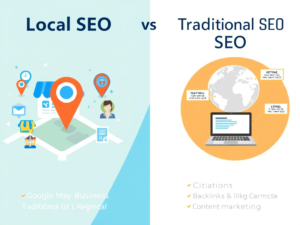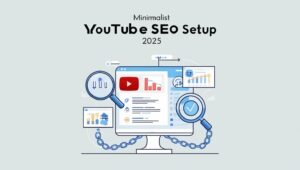Freelance Web Design
Introduction
As a freelance web designer, standing out in the crowded digital landscape is key to success. Defining your niche and identifying your ideal client are two crucial steps to building a thriving freelance web design business. Not only does this strategy help you refine your skills and portfolio, but it also makes it easier to find web design clients who truly value your expertise.

Table of Contents
Why Your Portfolio is Your Golden Ticket as a Freelance Web Designer
Think of your portfolio as your digital showroom. It’s your chance to:
- Showcase Your Skills: Your portfolio is the proof that you can translate design ideas into functional, beautiful websites. It’s where potential clients see your mastery of code, layout, user experience, and visual aesthetics.
- Build Trust and Credibility: A well-curated portfolio shows you’re serious about your craft. It gives clients confidence that you have the experience and talent to deliver on their project.
- Attract the Right Clients: Your portfolio acts like a magnet. By showcasing projects aligned with your ideal clients’ needs and industries, you’ll naturally draw in opportunities that excite you.
- Differentiate Yourself: In a sea of freelance web designers, your portfolio is your unique signature. It highlights your style, approach, and the value you bring to the table.
Crafting a Portfolio That Wows: Tips and Tricks
- Choose Your Platform Wisely:
- Portfolio Website: This gives you the most control and flexibility. You can use a content management system (WordPress, Wix, Squarespace) or build a custom site.
- Online Portfolio Platforms: Behance, Dribbble, and similar platforms offer a built-in community and visibility.
- Hybrid Approach: Combine a streamlined portfolio website with a presence on relevant platforms to maximize your reach.
- Curate Your Best Work:
- Quality Over Quantity: Don’t feel pressured to include every project. Highlight 5-10 of your strongest, most relevant pieces.
- Tell a Story: Each project should have a brief description explaining the client’s goals, your process, and the results achieved.
- Visuals Matter: Use high-quality images, screen captures, or even short videos to showcase your designs.
- Demonstrate Your Range:
- Diverse Projects: Include a variety of website types (e.g., e-commerce, blogs, portfolios) to demonstrate your versatility.
- Specialties: If you have a niche (like responsive design, animation, or specific industries), make sure it’s well-represented.
- Case Studies: Consider in-depth case studies for a few key projects to illustrate your problem-solving skills and strategic thinking.
- Optimize for Discovery:
- SEO (Search Engine Optimization): Use relevant keywords (like freelance web design, web designer, find web design clients) throughout your portfolio’s content and metadata.
- Social Media: Share your portfolio on LinkedIn, Twitter, and other platforms where potential clients might be lurking.
- Networking: Connect with other designers, agencies, and potential clients online and offline. Let them know you’re available for freelance work.
Bonus Tips:
- Testimonials: If you have glowing feedback from past clients, definitely include it!
- Call to Action: Make it easy for potential clients to contact you with a prominent “Hire Me” or “Contact” button.
- Keep It Fresh: Regularly update your portfolio with new work to show you’re active and engaged in your field.
Let’s Get Started!
Building your portfolio might seem like a daunting task, but remember, it’s an investment in your freelance web design career. Take your time, create something you’re proud of, and watch the opportunities start rolling in!
Setting Your Freelance Web Design Pricing & Services: A Comprehensive Guide
As a freelance web designer, determining the right pricing and services is a balancing act. You need to be competitive in the market while ensuring your work is valued fairly. Let’s delve into the strategies and options available:
Pricing Your Freelance Web Design Services Competitively and Fairly
- Understand Your Worth:
- Skills and Experience: Your expertise is your biggest asset. If you’re a seasoned freelance web designer, charge more than someone just starting.
- Portfolio: A strong portfolio showcases your capabilities and justifies higher rates.
- Market Research: Research what other freelance web designers are charging for similar services in your area and niche.
- Consider Your Expenses:
- Calculate your business costs (software, marketing, taxes, etc.).
- Factor in your desired income to cover living expenses and savings.
- Value-Based Pricing:
- Focus on the value you bring to clients. How much will your design impact their business?
- High-quality design, improved user experience, and increased conversions are all valuable outcomes you can leverage.
Pricing Models for Freelance Web Designers
- Hourly Rate:
- Suitable for smaller projects or when the scope is unclear.
- Track your time meticulously and ensure you’re compensated for meetings and revisions.
- Project-Based Pricing:
- Provide a fixed price for the entire project.
- Best for well-defined projects with clear deliverables.
- Ensure the contract outlines the scope and includes a buffer for unexpected changes.
- Retainer Model:
- Offer ongoing services for a fixed monthly fee.
- Ideal for clients who need regular website maintenance or updates.
- Provides predictable income for you and consistent support for the client.
Choosing the Right Pricing Model
Consider the following factors when deciding on a pricing model:
- Project Scope: Is it a one-time project or ongoing work?
- Client Budget: Be flexible and consider what your clients can afford.
- Your Preferences: Which model aligns best with your work style and income goals?
Creating a Clear List of Freelance Web Design Services
A well-defined list of services helps clients understand what you offer and makes it easier for them to hire you. Here are some common services offered by freelance web designers:
- Website Design: Complete website creation, including layout, graphics, and functionality.
- Landing Page Design: Design of focused pages aimed at specific conversions.
- Website Redesign: Revamping existing websites to improve aesthetics and functionality.
- Website Maintenance: Ongoing updates, security checks, and content management.
- E-commerce Development: Creation of online stores with shopping carts and payment gateways.
- Responsive Design: Ensuring websites look and function well on all devices.
- SEO Optimization: Improving website visibility in search engine results.
- Content Creation: Writing website copy, blog posts, or other content.
Be specific about what each service includes. For example, under “Website Design,” you could list:
- Custom design concepts
- Responsive design implementation
- Content management system (CMS) setup
- Basic SEO optimization
Additional Tips for Freelance Web Design Success
- Find Web Design Clients: Network online and offline, utilize freelance platforms, and showcase your work on a portfolio website.
- Communicate Clearly: Set clear expectations with clients regarding deliverables, timelines, and revisions.
- Deliver High-Quality Work: Strive for excellence in every project to build a strong reputation.
- Stay Updated: Keep up with the latest web design trends and technologies.
Establishing Your Freelance Web Design Business: A Comprehensive Guide
Becoming a successful freelance web designer involves more than just technical skills; it requires careful planning and attention to the legal and administrative aspects of running a business. Here’s a breakdown of the crucial steps involved:

1. Register Your Business:
- Choose a Business Structure: Decide whether you’ll operate as a sole proprietorship (simplest), a partnership, or a limited liability company (LLC) to protect your personal assets.
- Register Your Business Name: Check if your desired name is available and register it with your local government. Consider registering a domain name that matches your business name (e.g., “[invalid URL removed]”).
- Obtain Necessary Licenses and Permits: Check with your local authorities to see if any specific licenses or permits are required for freelance web design businesses in your area.
2. Create Contracts and Agreements:
- Develop Client Contracts: Have a well-drafted contract template that outlines project scope, timelines, payment terms, ownership of intellectual property, and dispute resolution procedures.
- Non-Disclosure Agreements (NDAs): Use NDAs when working with sensitive client information to protect confidentiality.
3. Manage Finances:
- Open a Separate Business Bank Account: Keep your business and personal finances distinct for easier bookkeeping and tax preparation.
- Track Income and Expenses: Utilize accounting software or a spreadsheet to meticulously track your income, expenses, and invoices. This is crucial for tax purposes and understanding your business’s financial health.
- Set Aside Money for Taxes: Estimate your tax liability and regularly set aside a portion of your income to avoid surprises during tax season.
4. Setting Up Your Workspace (Home Office):
- Designate a Dedicated Workspace: Choose a quiet, well-lit area in your home as your office. Having a separate workspace helps maintain focus and professionalism.
- Invest in Essential Equipment: Equip your workspace with a reliable computer, ergonomic furniture, a high-speed internet connection, and any specific web design software or tools you need.
- Organize Your Files: Create a system for organizing client files, project documents, and financial records, both physically and digitally.
5. Finding Clients:
- Build a Portfolio Website: Showcase your best web design projects on your website to attract potential clients. Optimize it with relevant keywords like “freelance web design,” “web designer,” and “how to freelance.”
- Network Online and Offline: Attend industry events, connect with other professionals on LinkedIn, and participate in relevant online communities to expand your network and reach potential clients.
- Market Your Services: Utilize social media platforms, online job boards, and freelance marketplaces to promote your freelance web design services.
Additional Tips for Success:
- Continuously Learn: Stay up-to-date with the latest web design trends, technologies, and software to maintain your competitive edge.
- Set Competitive Rates: Research industry standards and set your rates accordingly. Consider offering packages or hourly rates depending on the project’s complexity.
- Deliver Excellent Customer Service: Build long-term relationships with clients by providing exceptional service, meeting deadlines, and exceeding expectations.
- Don’t Forget Self-Care: Freelancing can be demanding. Prioritize rest, exercise, and maintaining a healthy work-life balance to avoid burnout.
Finding and Attracting Web Design Clients: A Freelance Guide
The lifeblood of any freelance web design business is a steady stream of clients. But how do you stand out in a crowded market? Here’s a multi-pronged approach:
1. Online Platforms: Cast a Wide Net
- Freelance Marketplaces: Upwork, Fiverr, Guru, and Freelancer are popular platforms to showcase your portfolio and bid on projects.
- Specialized Platforms: 99designs (for design contests) or Toptal (for high-end freelance talent) can connect you with specific client types.
- Job Boards: Indeed, LinkedIn, and even local job boards often list web design positions.
Pro Tip: Optimize your profiles on these platforms. Use strong keywords like “freelance web designer,” “freelance web design,” and list specific skills (e.g., WordPress, UI/UX, e-commerce design).
2. Networking: Build Genuine Relationships
- Your Existing Network: Reach out to friends, family, former colleagues, and classmates. You never know who might need a website or redesign.
- Online Communities: Participate in web design forums, Facebook groups, or subreddits. Share your expertise, answer questions, and build a reputation.
- Local Networking Events: Attend meetups, conferences, or workshops related to web design or small businesses.
Pro Tip: Networking is about building relationships, not just selling. Focus on genuine connections, offer value, and be approachable.
3. Referrals: Your Most Powerful Tool
- Ask for Referrals: When you finish a project successfully, don’t be afraid to ask your happy clients for referrals.
- Incentivize Referrals: Offer a discount to both the referrer and the new client for a win-win situation.
- Build Relationships with Other Freelancers: Collaborate with other freelancers (e.g., content writers, SEO specialists) who can refer clients to you.
Pro Tip: Deliver exceptional work and exceed client expectations. Happy clients are your best advocates.
Crafting Persuasive Proposals and Pitches
- Tailor to the Client: Research the client and their industry. Explain how your design will solve their specific problems or achieve their goals.
- Showcase Your Expertise: Highlight your skills (“freelance web design” experience), your process, and relevant examples from your portfolio.
- Offer a Clear Plan: Outline the project scope, timeline, deliverables, and pricing structure.
- Be Professional: Use clear, concise language, and proofread meticulously. A well-crafted proposal speaks volumes about your professionalism.
Effective Communication and Client Relationships
- Set Clear Expectations: Discuss project goals, timelines, budgets, and communication preferences upfront.
- Regular Updates: Keep clients informed of your progress, ask for feedback, and address concerns promptly.
- Be Responsive: Respond to emails and messages in a timely manner. Show that you value their time and input.
- Go the Extra Mile: Offer additional value, like a free website maintenance guide or tips for optimizing their site for SEO.
- Manage Feedback: Be open to feedback, but also be confident in your expertise. Explain your design choices and find solutions that work for both of you.
The “How to Freelance” Factor: Additional Tips
- Build Your Portfolio: Even if you’re starting out, create personal projects or offer to design websites for friends or family at a discounted rate.
- Market Yourself: Create a website showcasing your services, use social media to share your work, and consider running paid ads (if your budget allows).
- Continuous Learning: Web design is constantly evolving. Stay updated on the latest trends and technologies to remain competitive.
- Set Realistic Expectations: Freelancing has its ups and downs. Be prepared for slow periods and don’t get discouraged.
Market Your Freelance Web Design Business: A Comprehensive Guide
The lifeblood of a successful freelance web design career lies in effective marketing. By promoting your skills and services, you attract the right clients and build a thriving business. Here’s how to create a powerful marketing plan that leverages various channels and strategies.

1. Building Your Foundation: A Strong Online Presence
- Professional Website: Your website is your virtual storefront. Showcase your best work, highlight your skills as a freelance web designer, and make it easy for potential clients to contact you.
- Portfolio: Curate a portfolio of your top web design projects. This demonstrates your expertise and provides visual proof of your abilities. Include a variety of projects to show your versatility.
- Client Testimonials: Positive feedback from past clients builds credibility. Ask satisfied clients to write testimonials about their experience working with you.
- Online Directories: List your freelance web design services on platforms like Upwork, Fiverr, and Guru. Optimize your profiles with relevant keywords like how to freelance and find web design clients.
2. Leveraging Social Media
- Choose the Right Platforms: Focus on platforms where your target audience hangs out. LinkedIn is great for professional networking, while Instagram or Pinterest might be better for visually driven businesses.
- Share Engaging Content: Post regularly about your work, industry trends, and design tips. Use relevant hashtags like #freelancewebdesigner and #webdesign.
- Interact with Your Audience: Respond to comments and messages promptly. Participate in relevant online communities and groups to network with potential clients.
3. Content Marketing: Establish Yourself as an Expert
- Blog: Share valuable insights and information about web design through a blog. This helps you rank higher in search engines for terms like freelance web design and how to freelance.
- Guest Posting: Contribute articles to other websites and publications related to web design. This exposes your work to a wider audience and builds backlinks to your website.
- Case Studies: Share in-depth case studies that demonstrate how your web design solutions have helped clients achieve their goals.
4. Online Advertising
- Paid Social Media Ads: Target specific demographics and interests to reach potential clients who are actively looking for freelance web designers.
- Google Ads: Use Google Ads to display your website at the top of search results for keywords like find web design clients.
- Remarketing: Show ads to people who have previously visited your website to encourage them to return and consider your services.
5. Networking and Referrals
- Attend Industry Events: Networking events and conferences are great opportunities to meet potential clients and build relationships with other professionals.
- Referral Programs: Encourage satisfied clients to refer you to their network by offering incentives or discounts.
6. Building Your Brand
- Define Your Niche: Specialize in a particular type of web design (e.g., e-commerce, small businesses) to differentiate yourself from the competition.
- Create a Unique Brand Identity: Develop a memorable logo, color scheme, and overall brand personality that reflects your style and values.
- Consistent Messaging: Use consistent messaging across all your marketing channels to reinforce your brand identity.
7. Measuring and Adapting
- Track Your Results: Monitor the effectiveness of your marketing efforts by tracking website traffic, social media engagement, and lead generation.
- Adjust Your Strategy: Analyze your data to identify what’s working and what’s not. Adapt your marketing plan as needed to optimize your results.
Key Takeaways:
- Building a successful freelance web design business takes time and consistent effort.
- Focus on delivering high-quality work and providing excellent customer service.
- Be patient, persistent, and adaptable in your marketing approach.
By following this comprehensive guide and incorporating relevant keywords naturally, you’ll be well on your way to attracting a steady stream of clients and building a thriving freelance web design business.
Conclusion: Your Freelance Web Design Adventure Starts Now
Embarking on a freelance web design journey is both exciting and rewarding. By following these key steps, you’ll be well on your way to establishing a thriving business:
- Hone Your Skills: Master the fundamentals of web design, from coding to design principles, and stay updated on the latest trends and technologies.
- Define Your Niche: Identify your ideal clients and specialize in a specific type of web design (e.g., e-commerce, portfolio sites, blogs).
- Build Your Portfolio: Showcase your best work to attract potential clients. Even if you don’t have paid work yet, create personal projects or offer discounted services to friends and family to get started.
- Set Your Rates: Research industry standards and determine fair pricing for your services. Consider offering package deals or hourly rates.
- Market Your Services: Create a professional website, network with other freelancers and potential clients, and utilize online platforms to find freelance web design gigs.
Remember, the life of a freelance web designer offers flexibility, creative control, and the potential for financial independence. You have the power to set your own schedule, choose the projects you love, and build a business that aligns with your passions.
Don’t wait any longer! Take that first step today, and soon you’ll be designing stunning websites, making a difference for your clients, and enjoying the freedom of freelancing. The world of freelance web design is waiting for you – dive in and start creating your own success story.
FAQs
What is freelance web design?
Freelance web design is the practice of designing and developing websites independently, on a project-by-project basis, for various clients. Freelance web designers offer their expertise in exchange for a fee, often setting their own schedules and working remotely.
Why should I hire a freelance web designer?
Flexibility: Freelancers adapt to your timeline and needs, offering personalized attention.
Cost-effective: Freelancers often have lower overhead than agencies, translating to potential savings.
Specialization: Many freelance web designers specialize in specific niches or industries, providing targeted expertise.
Fresh perspective: Freelancers bring unique creative vision and ideas to the table.
How do I find freelance web design clients?
Network: Attend industry events, join online communities, and leverage your existing connections.
Online platforms: Create profiles on freelance marketplaces (like Upwork or Fiverr) and web design-specific platforms.
Content marketing: Showcase your expertise by writing blog posts, creating tutorials, or offering free resources on your website.
Cold outreach: Directly contact potential clients with a personalized pitch highlighting your skills.
How much does a freelance web designer charge?
Pricing varies widely depending on the designer’s experience, location, project complexity, and the services offered. Some freelancers charge hourly rates, while others prefer project-based fees. It’s essential to discuss your budget and expectations upfront to avoid misunderstandings.
What skills does a freelance web designer need?
Technical Skills:Proficiency in HTML, CSS, and JavaScript
Understanding of responsive design principles
Knowledge of content management systems (e.g., WordPress, Drupal)
Soft Skills:Excellent communication and interpersonal skills
Strong project management abilities
Effective time management
Creativity and problem-solving aptitude
How do I become a successful freelance web designer?
Hone your skills: Continuously learn and update your knowledge of the latest web design trends and technologies.
Build a strong portfolio: Showcase your best work to attract potential clients.
Establish your brand: Create a professional website and social media presence.
Market your services: Actively seek out clients and promote your expertise.
Deliver exceptional service: Exceed client expectations to build a loyal customer base and earn referrals.





